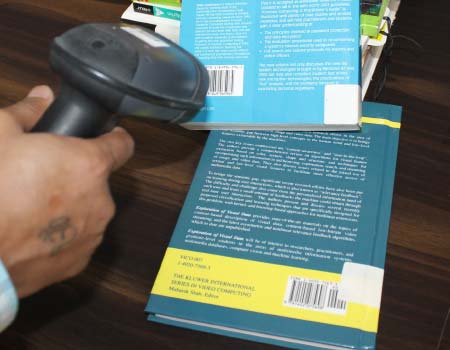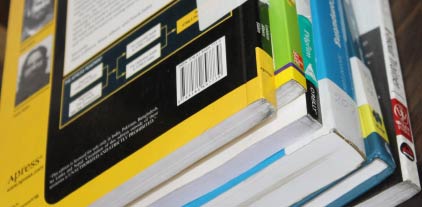The library barcode patron identifier is usually a barcode or numeric code assigned to each library patron. This code is linked to the patron's library account and allows the library to track which items have been checked out by which patrons. It may also include information such as the patron's name and address, the due date of the item, and any fines or fees associated with the item.
Information Of Library Barcode Software
A library barcode typically includes a unique identifier for the library's catalog system, as well as a unique identifier for the patron who has checked out the item.
In addition to the catalog and patron identifiers, a library barcode may also include other information such as the title, author, and call number of the item. This information is typically encoded in the barcode using a specific format such as the Interleaved 2 of 5 (ITF) or Code 39 barcode symbologies.
Uses Of Library Barcode Application
It is a type of barcode that contains information about the item, such as the title, author, and publication date, and it can be scanned by a barcode scanner to retrieve this information.
In a library setting, barcodes are typically used in two ways:
- Item Checkout: Each library item is assigned a unique barcode, which is scanned at the time of checkout to identify the item and link it to the patron who has borrowed it. This allows the library to track which items have been borrowed and who currently has them.
- Inventory Management: Barcodes are also used to track the location and status of library items. Each item is labeled with a barcode that is linked to its record in the library's database. Library staff can use barcode scanners to quickly locate items on the shelves, identify missing items, and update the status of items as they are checked in or out.
The use of barcode systems in libraries has become increasingly common in recent years, as libraries seek to improve their efficiency and provide better service to patrons. By implementing barcode systems, libraries can streamline their operations, reduce errors, and ensure that their collections are properly managed and tracked.
Download and Install Library Barcode Application
DOWNLOADWorking Of Library Barcode Software

-
A library barcode is a unique identifier code assigned to library items such as books, DVDs, and other materials to facilitate their tracking and management within a library system. The barcode contains information about the item, such as the title, author, and publication date, and it can be scanned by a barcode scanner to retrieve this information.
-
The library barcode system works by assigning each library item a unique barcode. When a patron checks out an item, the item's barcode is scanned and linked to the patron's library account. This allows the library to track which items have been borrowed and who currently has them.
-
In addition to tracking the circulation of library items, barcodes are also used for inventory management. Each item is labeled with a barcode that is linked to its record in the library's database. Library staff can use barcode scanners to quickly locate items on the shelves, identify missing items, and update the status of items as they are checked in or out.
-
The use of barcode systems in libraries has become increasingly common in recent years, as libraries seek to improve their efficiency and provide better service to patrons. By implementing barcode systems, libraries can streamline their operations, reduce errors, and ensure that their collections are properly managed and tracked.
Different Types of Library Barcodes
Barcodes are commonly used in libraries to identify and track library materials, as well as to manage borrowing and return processes. The most common types of barcodes used in libraries are:
-
Library of Congress Control Number (LCCN): LCCN barcodes are used to identify library materials that have been assigned a Library of Congress Control Number. They consist of a series of bars and spaces that encode a unique number assigned by the Library of Congress.
-
International Standard Book Number (ISBN): ISBN barcodes are used to identify books and other library materials that have been assigned an ISBN. These barcodes typically consist of a series of bars and spaces that encode a 13-digit number.
-
Code 39: Code 39 barcodes are commonly used in libraries for inventory tracking and asset management. They can encode alphanumeric characters and are often used for labeling non-book items, such as DVDs and CDs.
-
International Standard Serial Number (ISSN): ISSN barcodes are used to identify serial publications, such as magazines and journals. They consist of a series of bars and spaces that encode an 8-digit number.
-
Code 128: Code 128 barcodes are also used for inventory tracking and asset management in libraries. They can encode a large amount of data, including letters, numbers, and symbols.
Create Barcodes for Library's Books and other Materials
To create barcodes for your library's books and other materials, you can follow these steps:

-
Obtain a Barcode Font or
Software:
You can purchase or download barcode fonts or software that can generate different types of barcodes such as Code 39, Code 128, or ISBN barcodes.
-
Install the Barcode Font or
Software:
Once you have obtained the barcode font or software, install it on your computer.
-
Generate Barcodes:
Use the barcode font or software to create barcodes for your library's books and materials. Enter the relevant information such as the title, author, publisher, and ISBN number, and generate the barcode.
-
Print the Barcodes
Print the barcodes on labels or directly onto the book or material using a barcode printer.
-
Test the Barcodes:
Test the barcodes using a barcode scanner to ensure that they can be read accurately.
Download and Install Library Barcode Application
DOWNLOADHow accurate are barcodes for tracking library materials
-
01
Barcodes are generally very accurate for tracking library materials, provided that they are properly implemented and maintained. Barcode technology has become a standard tool in libraries, and it is widely used to track library materials, such as books, journals, and other items. library's books to ensure compatibility with your system and other industry.
-
02
When a library item is scanned, the barcode is read and the library management software automatically records the relevant information, including the item's title, author, publication date, and other data. This allows librarians to manage their collections, track items as they are checked in and out, and ensure that library materials are properly accounted for.
-
03
However, the accuracy of library barcodes can be affected by a variety of factors. For example, if a barcode is damaged or incorrectly labeled, it may not be read properly by a scanner, leading to inaccurate inventory data. Similarly, if the barcode scanner or software is not properly calibrated, it may fail to capture all of the necessary information, leading to incomplete or inaccurate data and application.
-
04
To ensure the accuracy of library barcodes, it is important to follow best practices for barcode labeling and scanning, including using high-quality barcode labels, properly calibrating barcode scanners, and regularly testing the system to ensure that it is functioning properly. Additionally, it is important to train library staff on how to properly label and scan items to ensure that the data is accurate and reliable.
Overall, the use of barcodes in libraries is primarily focused on identifying and tracking library materials, as well as managing borrowing and return processes. The type of barcode used will depend on the type of library material being identified and the specific needs of the library.
